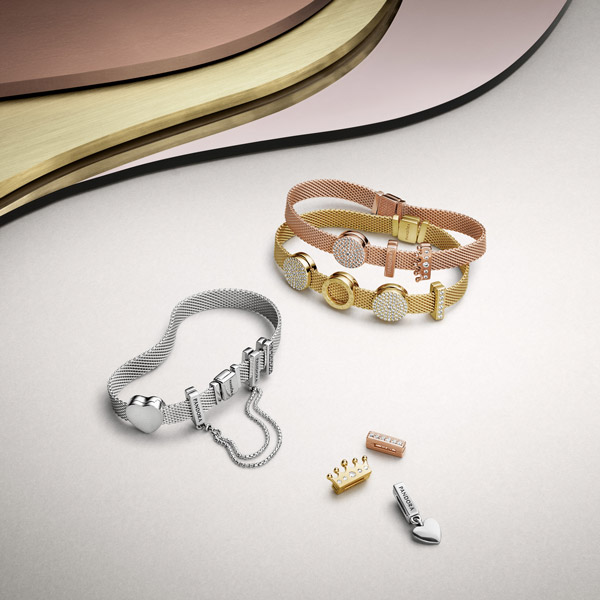
Back in October, charm company Pandora debuted a new collection—Reflexions—in its efforts to expand its portfolio of product concepts. The collection, which comprises a flat-style bracelet and interchangeable, clip-on charms, was the second new concept for the brand in 2018, and it was heavily promoted on social media.
Pandora worked with its media agency, Mindshare, to craft an approach to targeting its audience on Twitter using the social platform’s ad suite, which includes demographic-targeting tools, to reach the desired buyers (for Pandora, it was women ages 18–54 who are interested in fashion, shopping, accessories, and jewelry).
With a series of video teasers, interactive audience polls, and photo carousels of the new collection, Pandora hit the campaign trail hard, with results showing an increase in everything you want to see: campaign awareness, tweet recall, and a higher average view rate and higher engagement than retail-industry benchmarks.
In Pandora’s case, this was a paid campaign done in partnership with an experienced agency team and with the help of Twitter’s ad suite of tools (it was also promoted across other channels, including Instagram). Not every retailer will fit this in their budget or feel comfortable jumping in with both feet. But that doesn’t mean that Pandora’s efforts can’t be emulated, at least in terms of strategy. In fact, Twitter offers guidelines for building a successful product launch, which can be repurposed for any number of collection debuts and even for things like big company announcements or can’t-miss store sales.
Sure, if you have some ad dollars allocated to social media, do it—Twitter has an excellent set of tools to help you to reach your target audience, amplify your message, and measure your results. If you are going to go that route, read the aforementioned guidelines here.
But if you don’t have ad dollars behind it, can you still announce a new product (or share some really big news) in an epic way on social media? Your results may not be on quite the same scale, but if your audience is attentive, why not?
Start Teasing Early—But Not Too Early
An exclusive first look at our newest bracelet design available October 4th. Which style will you choose? #PANDORAReflexions https://t.co/vzFFTwbLxu pic.twitter.com/UixCxqpIEQ
— PANDORA N. America (@PANDORA_NA) September 27, 2018
Whether it’s Pandora’s new collection or Taylor Swift’s new album, sending out teasers—particularly ones that don’t give away too much—helps to build anticipation. You can do this through imagery on Twitter, or through your Instagram feed and Stories, as well as on Facebook. You want to give your followers enough time to get excited, but not too much time between your tease and reveal, as they’ll just forget anyway (we can’t all be like Game of Thrones). According to Twitter, conversations about organically shared news tend to peak within about 48 hours, so you don’t want to miss your window to sustain the conversation.
Build Engagement
What bracelet reflects your style? #PANDORAReflexions
— PANDORA N. America (@PANDORA_NA) October 18, 2018
Keep your audience engaged on the heels of your teaser by asking them to contribute their voices. On launch day, Pandora posed questions such as the one above—a simple “Which do you like better?”—that served to promote its new collection, while asking its audience for feedback. You could ask the audience in the same way, by sharing images of a new collection and polling them through any or all of the social media channels. You could also create questions that reveal less, like clues to keep the audience captivated, intrigued, and engaged. Get creative with it.
The Big Reveal
When the time comes to actually send your product launch (or company announcement) into orbit, make sure it’s as thoughtfully done as the entirety of your campaign. You don’t want to spend all this time building up your audience to—womp, womp—post a single product photo or a text-only announcement. You’ve got to go all in if you plan to do something like this, even if your audience seems small. For its collection reveal, Pandora shared videos, photo carousels, and interactive polls (as seen above) with its followers. To make it epic, you’re going to want to keep all of your social channels buzzing with compelling content—particularly in places like Twitter and Instagram Stories. This is where Twitter recommends a promoted ad, which would certainly be useful. But if you don’t go the paid route, try to craft your plan based on the busiest times on your account. When do you seem to get the most likes and comments on your posts? Is there a particular day of the week that your audience seems more engaged? Twitter, among others, offers platforms that can measure these stats for you (there are also free, albeit less thorough, tools available online). Whatever your path, be mindful of your audience—this is for them, after all!
Top: Pandora’s Reflexions collection
Follow JCK on Instagram: @jckmagazineFollow JCK on Twitter: @jckmagazine
Follow JCK on Facebook: @jckmagazine